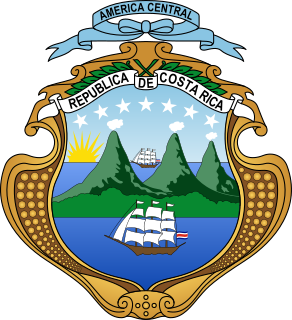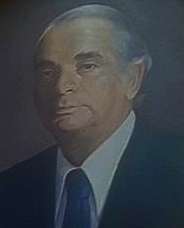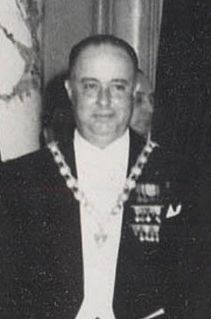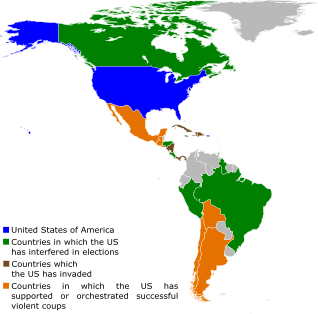| ||||||||||||||||||||
| ||||||||||||||||||||
In green provinces won by Arias, in blue Calderón | ||||||||||||||||||||
| ||||||||||||||||||||
 |
|---|
| This article is part of a series on the politics and government of Costa Rica |
Legislature |
|
General elections were held in Costa Rica on 2 February 1986. [1] Óscar Arias of the National Liberation Party won the presidential election, whilst his party also won the parliamentary election. Voter turnout was 81.8%. [2]

Costa Rica, officially the Republic of Costa Rica, is a country in Central America, bordered by Nicaragua to the north, the Caribbean Sea to the northeast, Panama to the southeast, the Pacific Ocean to the southwest, and Ecuador to the south of Cocos Island. It has a population of around 5 million in a land area of 51,060 square kilometers. An estimated 333,980 people live in the capital and largest city, San José with around 2 million people in the surrounding metropolitan area.

Óscar Arias Sánchez was President of Costa Rica from 1986 to 1990 and from 2006 to 2010. He received the Nobel Peace Prize in 1987 for his efforts to end the Central American crisis.

The National Liberation Party, nicknamed the verdiblancos, is a political party in Costa Rica. The party is a member of the Socialist International.
Contents
Costa Rica was under a strong two-party system at the time. The country was undergoing military tensions with neighboring Nicaragua due to the recently happened Sandinista Revolution and Nicaragua's dictator Daniel Ortega's fighting of the right-wing Contra rebel guerilla in its southern border disregarding the official limits and confronting Costa Rica's police and security forces. Such skirmishes left one policeman's death and several wounded and both countries at the edge of war. Whilst some people blamed former president Rodrigo Carazo for allowing the FSLN to operate in the Costa Rican northern territory against then dictator Anastasio Somoza, others resented President Luis Alberto Monge's hawkish behavior toward Sandinista Nicaragua and his support of the Contras. [3]
A two-party system is a party system where two major political parties dominate the government. One of the two parties typically holds a majority in the legislature and is usually referred to as the majority or governing party while the other is the minority or opposition party. Around the world, the term has different senses. For example, in the United States, Jamaica, and Malta, the sense of two-party system describes an arrangement in which all or nearly all elected officials belong to one of the only two major parties, and third parties rarely win any seats in the legislature. In such arrangements, two-party systems are thought to result from various factors like winner-takes-all election rules. In such systems, while chances for third-party candidates winning election to major national office are remote, it is possible for groups within the larger parties, or in opposition to one or both of them, to exert influence on the two major parties. In contrast, in the United Kingdom and Australia and in other parliamentary systems and elsewhere, the term two-party system is sometimes used to indicate an arrangement in which two major parties dominate elections but in which there are viable third parties which do win seats in the legislature, and in which the two major parties exert proportionately greater influence than their percentage of votes would suggest.

Nicaragua, officially the Republic of Nicaragua, is the largest country in the Central American isthmus, bordered by Honduras to the northwest, the Caribbean to the east, Costa Rica to the south, and the Pacific Ocean to the southwest. Managua is the country's capital and largest city and is also the third-largest city in Central America, behind Tegucigalpa and Guatemala City. The multi-ethnic population of six million includes people of indigenous, European, African, and Asian heritage. The main language is Spanish. Indigenous tribes on the Mosquito Coast speak their own languages and English.

José Daniel Ortega Saavedra is a Nicaraguan politician serving as President of Nicaragua since 2007; previously he was leader of Nicaragua from 1979 to 1990, first as Coordinator of the Junta of National Reconstruction (1979–1985) and then as President (1985–1990). A leader in the Sandinista National Liberation Front, his policies in government have seen the implementation of leftist reforms across Nicaragua.
Former minister and deputy Oscar Arias faced former vice president Carlos Manuel Castillo in closed primaries. Castillo had the support of PLN's traditional leadership including former presidents and party's founders José Figueres Ferrer, Daniel Oduber Quirós and Luis Alberto Monge. [4] Arias was seen as a young, alternative candidate and the "underdog" in the election, but managed to earn the majority of votes and popular support. [4]

The 1949 Constitution of Costa Rica established two Vice-Presidencies of Costa Rica, which are directly elected through a popular vote on a ticket with the president for a period of four years, with no immediate re-election. There has been various incarnations of the office. Vice presidents replace the president in cases of temporary or permanent absence.

José María Hipólito Figueres Ferrer served as President of Costa Rica on three occasions: 1948–1949, 1953–1958 and 1970–1974. During his first term in office he abolished the country's army, nationalized its banking sector, and granted women and Afrodescendents the right to vote, as well as access to Costarrican nationality to people of African descent. He was a good friend of the Governor of Puerto Rico, Luis Muñoz Marín, praising his political achievements in one of his essays.

Porfirio Ricardo José Luis Daniel Oduber Quirós was a Costa Rican politician, lawyer, philosopher, poet, and essayist. He served as the President of Costa Rica from 1974 to 1978. He is credited with the creation of the Sistema Nacional de Radio y Televisión and the Universidad Estatal a Distancia.
On the other side of the two-party system former Foreign Minister (under Carazo's administration) Rafael Ángel Calderón Fournier, son of historical leader of Calderonismo Rafael Ángel Calderón Guardia, was nominated by the Social Christian Unity Party, then main opposition force. This was Calderón's second attempt to win the Presidency.

Rafael Ángel Calderón Fournier served as President of Costa Rica from 1990 to 1994. He was the presidential candidate of the Social Christian Unity Party for the national elections held in February 2010, but resigned his candidacy on 5 October 2009, when he was sentenced to five years in prison for two counts of corruption.

Rafael Ángel Calderón Guardia was a Costa Rican doctor and politician, who served as President from 1940 to 1944.

The Social Christian Unity Party is a centre-right political party in Costa Rica.
During the campaign the topic of peace was central. Calderón tried to present himself as a hawk who felt no quarrels in facing Nicaragua militarily. Arias on the contrary tried to show himself as a man of peace and negotiator who would pacified the region. His slogan was "Paz para mi gente" (Peace for my People). [3] In fact, some analysts also saw Arias' position as a strong criticism of Monge, of his own party, and his hardline position. Monge and Arias would be political enemies ever since. [3]
PLN campaign also focused in showing Calderón as a man of war and remembering old historical periods, blaming Calderonism for the 1948 Civil War and the 1955 Somoza-endorsed Calderonistas' invasion attempt. The party even went so far as to show Calderón in a cartoon as a spoil kid ready for war wearing the clothing of Quico, a popular character from El Chavo del Ocho . [5]
The Costa Rican Civil War was the bloodiest event in 20th-century Costa Rican history. It lasted for 44 days, during which approximately 2,000 people are believed to have died. The conflict was precipitated by the vote of the Costa Rican Legislature, dominated by pro-government representatives, to annul the results of the presidential elections held in February, alleging that the triumph of opposition candidate Otilio Ulate had been achieved by fraud.

Anastasio "Tacho" Somoza García was officially the 21st President of Nicaragua from 1 January 1937 to 1 May 1947 and from 21 May 1950 to 29 September 1956, but ruled effectively as dictator from 1936 until his assassination. Anastasio Somoza started a dynasty that maintained absolute control over Nicaragua for 55 years.

El Chavo is a Mexican television sitcom that gained enormous popularity in Latin America as well as in Spain, the United States and other countries.











